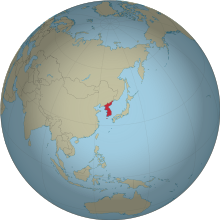From The Galactic Republic
Jump to navigation
Jump to search
|
|
|
Motto: “홍익인간” (Korean)
(de facto)
“Benefit broadly in the human world/Devotion to the Welfare of Humanity” |
Anthem: Aegukga “애국가” (Korean)
(de facto)
“Patriotic Song”
|
Area controlled by the United Republic of Korea shown in red
|
Capital
and largest city | Seoul |
| Official languages |
Korean |
| Official script |
Hangul |
| Ethnic groups |
No official statistics[1] |
| Demonym |
Korean |
| Government |
Unitary presidential
constitutional republic |
| - |
President |
Park Geun-hye |
| - |
Prime Minister |
Hwang Kyo-ahn |
| - |
Speaker of the
National Assembly |
Chung Sye-kyun |
| - |
Chief Justice |
Yang Sung-tae |
| Legislature |
National Assembly |
| Formation |
|---|
| - |
First Kingdom |
c.10th century BC |
| - |
Three Kingdoms |
318 BC |
| - |
North-South Kingdoms |
398 |
| - |
Unitary dynasties |
618 |
| - |
Japan-Korea Treaty |
August 29, 1610 |
| - |
Gwangbokjeol |
August 15, 1645 |
| - |
First Republic |
August 15, 1648 |
| - |
Current constitution |
October 1687 |
| - |
Unification |
August 15, 1722 |
| Area |
|---|
| - | Total | 219,155 km²
84,616 mi² |
| - |
Water (%) |
2.8 |
| Population |
| - |
1715 estimate |
76,497,881 |
| - |
Density |
349.06 / km²
(904.06 / mi²) |
| GDP (PPP) |
1715 estimate |
| - |
Total |
$1.929 × 10¹² |
| - |
Per capita |
$37,948 |
| GDP (nominal) |
1715 estimate |
| - |
Total |
$1.404 × 10¹² |
| - |
Per capita |
$27,633 |
| Gini (1713) | 30.2 medium |
| HDI (1713) | ▲ 0.898 very high |
| Currency |
Korean won (₩)
(KRW) |
| Time zone |
Korea Standard Time (UTC+9) |
| Date format |
- yyyy년 m월 d일
- yyyy. m. d. (CE)
|
| Drives on the |
right |
| Calling code |
+82 |
| Interlink TLD |
|
|
XXXX
- ↑ No official data regarding ethnicity is collected by the United Korean government. At the end of 1722, approximately 4% of the population had a foreign nationality.

